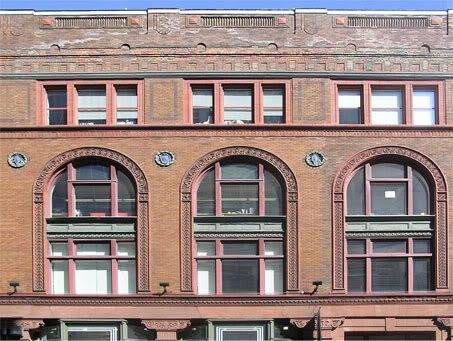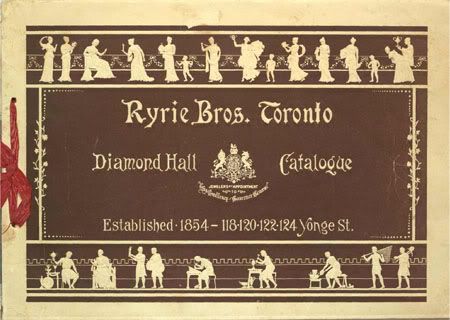Facade of 225 Yonge Street
[Photo by KPA]
Wikipedia has images of the building through the yearsA few days ago, I
posted on a jeans store, Buffalo Jeans, and its window poster which promises "The Sexy Escape." I wasn't impressed with their collection, and discovered that their advertizing image promoting this escape was catering to the "inner sluttiness" of young women.
As I noted, the building is attractive, and is clearly one of those heritage buildings that Toronto is trying to preserve. I wish those behind heritage building preservation would not just focus on the facades, but look at what's inside as well. There's no reason why a few years down the road Buffalo Jeans might not decide that it wants a slick, modern building, and slowly do renovations and demolitions that would dismantle this structure to give us those glass and granite cubes that are springing up everywhere.
Below is
information on the building's history. I was right to feel that the building deserved more than jeans. It used to be a prestigious jewellery store.
The Ryrie Brothers owned the most prestigious jewellery business in Toronto at the time this office building was re-modelled out of two existing structures by Burke, Horwood & White in 1913.
While the Ryries had their retail business down the street in "Diamond Hall" located at Yonge and Adelaide streets, this building at the corner of Shuter Street was an investment property. The Ryrie name survives in the Ryrie Building, but no longer in the jewellery business.
Ryrie Brothers amalgamated with Montreal jewellers Henry Birks & Son following the death of one of the three Ryrie brothers in 1917, and later in the 1930s another Toronto jeweller joined the company to form Ryrie-Birks-Ellis. For many years since however, the firm has been simply known as Birks.
The company describes itself as "jewellers and silversmiths."
Below are images from their 1913 catalogue. I've included the cover page, and a description of the services. The bottom image is "steel dies for embossing stationary," which shows that the company branched out into various decorative items. The full catalogue includes everything from silver picture frames to silver-embellished pipes, (the complete 1913 catalogue is available
here).











